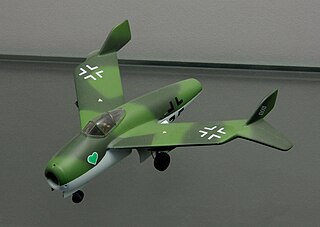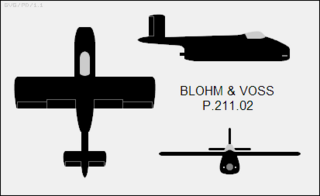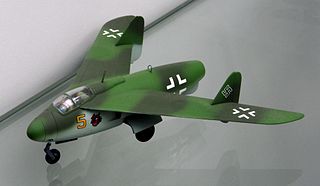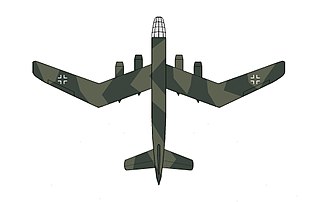Related Research Articles

The Heinkel He 162 Volksjäger was a German single-engine, jet-powered fighter aircraft fielded by the Luftwaffe in World War II. Developed under the Emergency Fighter Program, it was designed and built quickly and made primarily of wood as metals were in very short supply and prioritised for other aircraft. Volksjäger was the Reich Air Ministry's official name for the government design program competition won by the He 162 design. Other names given to the plane include Salamander, which was the codename of its wing-construction program, and Spatz ("Sparrow"), which was the name given to the plane by the Heinkel aviation firm.

The Blohm & Voss BV 238 was a German flying boat, built during World War II. It was the heaviest aircraft ever built when it first flew in 1944, and was the largest aircraft produced by any of the Axis powers during World War II.

The Heinkel HeS 011 or Heinkel-Hirth 109-011(HeS - Heinkel Strahltriebwerke) was an advanced World War II jet engine built by Heinkel-Hirth. It featured a unique compressor arrangement, starting with a low-compression impeller in the intake, followed by a "diagonal" stage similar to a centrifugal compressor, and then a three-stage axial compressor. Many of the German jet-powered aircraft designs at the end of the war were designed to use the HeS 011, but the HeS 011 engine was not ready for production before the war ended in Europe and only small numbers of prototypes were produced.

The Messerschmitt P.1101 was a single-seat, single-jet fighter project of World War II, developed as part of the 15 July 1944 Emergency Fighter Program which sought a second generation of jet fighters for the Third Reich. A prominent feature of the P.1101 prototype was that the sweep angle of the wings could be changed before flight, a feature further developed in later variable-sweep aircraft such as the Bell X-5 and Grumman XF10F Jaguar.
The Focke-Wulf Project I was a design study for a jet fighter, to be built in Germany during World War II. In 1942, the Reichsluftministerium (RLM) asked Professor Kurt Tank of the Focke-Wulf factory to investigate the possibility of a single-engine jet fighter. He was given the development plans of the BMW 003, Jumo 004 and Heinkel HeS 011 engines. Late in 1942 the Project Office, led by Ludwig Mittelhuber, began to work on a series of fighter projects, to be powered by one of these new turbojet units.

The Focke-Wulf Flitzer was a jet fighter under development in Germany at the end of World War II.

The Blohm & Voss P 194 was a German design for a mixed-power Stuka or ground-attack aircraft and tactical bomber, during World War II.

The Blohm & Voss P 212 was a proposed jet fighter designed by Blohm & Voss for the Emergency Fighter Program Luftwaffe design competition during the Second World War.

The Blohm & Voss P 211 was a design proposal submitted by Blohm & Voss to the Volksjäger jet fighter competition of the Luftwaffe Emergency Fighter Program towards the end of the Second World War.

The Blohm & Voss P 213 was a submission to the Miniaturjäger programme of the Luftwaffe Emergency Fighter Program towards the end of the Second World War. The Miniaturjäger was to be powered by a pulse jet but the programme was scrapped in December 1944.

The Junkers EF 128 was a project for a single-engine jet fighter, developed for the Emergency Fighter Program Luftwaffe design competition during the Second World War.

The Heinkel P.1078 was a single seat interceptor developed for the Luftwaffe by Heinkel aircraft manufacturing company under the Emergency Fighter Program during the last years of the Third Reich.

The Messerschmitt P.1110 was a design for a single-seat, high-altitude interceptor, prepared for the German Luftwaffe by the Messerschmitt aircraft manufacturing company, under the Emergency Fighter Program during the last months of World War II.

The Blohm & Voss Bv P 188 was a long-range, heavy jet bomber design project by the Blohm & Voss aircraft manufacturing division during the last years of the Third Reich. It featured a novel W-wing planform with variable incidence.
The Blohm & Voss P215 was an advanced jet night fighter project by Blohm & Voss during the Second World War. With a crew of three and twin jet engines, it featured a tailless swept-wing layout and heavy armament. An order for three prototypes was received just weeks before the war ended.
The Blohm & Voss P 203 was a design project for a heavy fighter during World War II. Capable of filling the roles of night fighter, light bomber and ground-attack, it had mixed propulsion, having both piston engine driven propellers and jet engines.
The Blohm & Voss P 209 was one of a series of single-engined jet fighter design studies. Under development in the latter half of 1944, when the single-engined jet fighter requirement was issued the P 209 was radically revised to meet the deadline but was not taken further by the RLM.
The Blohm & Voss P.202 was an unusual design study for a variable-geometry jet fighter during World War II. It was the first design to incorporate a slewed wing in which one side swept forward and the other back. The P.202 was never built or flown.
The Blohm & Voss P 204 was one of several design studies by Blohm & Voss for asymmetric dive bombers during World War II. It was also unusual in having hybrid propulsion comprising both piston and jet engines.
References
Notes
- ↑ Sharp 2015, p. 126.
- ↑ Nowarra 1993.
- 1 2 Sharp 2017, pp. 68, 73.
- 1 2 Masters 1982, p. 36.
Bibliography
- Masters, David (1982). German Jet Genesis. Jane's.
- Nowarra, Heinz J. (1993). Die Deutsche Luftruestung 1933–1945, Vol. 1, AEG-Dornier (in German). Bernard & Graefe.
- Sharp, Dan (2015). Luftwaffe: Secret Jets of the Third Reich. Mortons.
- Sharp, Dan (2017). Luftwaffe: Secret Wings of the Third Reich. Mortons.